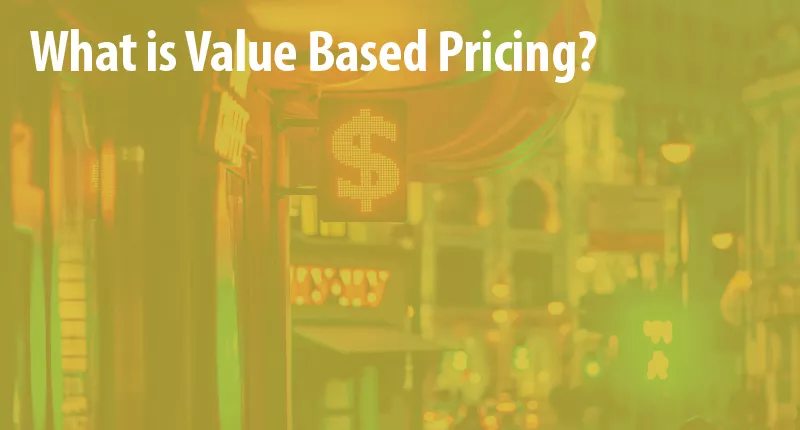
TABLE OF CONTENTS
Running an online business is just as much work as running a retail store, and a value-based pricing strategy gives you the opportunity to receive what your business and brand are both worth. There are many aspects of your operational strategy that determine the success or failure of your business. One such decision is your pricing strategy. The price you charge should cover your operating expenses and provide a solid profit on top. Having a pricing strategy that doesn’t accomplish this will hurt your profitability. That being said, if you price yourself too high, it could affect the number of sales. Some Businesses have various pricing strategies including competitor-based pricing and cost-plus pricing. However, these types of strategies are often ineffective.
Value-based pricing is often the ideal choice for positively affecting your bottom line while building a good brand identity and focusing on customer relationships. Read on to learn more about value-based pricing and how to decide if it’s the right fit for your business.
What is Needed for Value-Based Pricing?
The idea behind value pricing is that you make your customers feel happy about the price they’re paying for your products or services because of the value they’re getting. This perception helps ensure that you’re not losing out on money or customers. When you price your products/services based on the value your customer thinks it brings, it also aligns with their expectations.

For instance, think about a major brand like Nike. Their Air Jordan shoes are almost twice the cost of other basketball shoes. However, the customers who buy these shoes don’t mind this higher cost because they feel that they are receiving more value for their dollar in comparison to other brands.
As a result, this pricing value creates a stronger brand, improves customer relationships, and raises your profitability. In this scenario, both you and your customers win. However there are a few factors you need to consider before pricing your products:
- Credit Card Processing Fees. How much are you being charged per transaction? Does this amount change per the payment method or any other factors? You’ll need to consider your average credit card processing fees when setting your prices.
- Discount or Surcharge Programs. Will you be offering any ongoing discounts or fee structures to your customers? For example, you should know the value of cash discounts and surcharge programs and if you’ll be implementing them.
- Omnichannel Retail. Will you be utilizing more than one outlet to sell your products or services? If so, you’ll need to create an omnichannel strategy for pricing.
- Any Other Overhead Costs. Running a business comes at a cost. Consider expenses such as labor, utilities, equipment cost, etc. when utilizing value-based pricing.
Who is Value Pricing for?
Value-based pricing can be used by almost any type of business. It’s especially helpful for eCommerce businesses because it can be used as a powerful marketing tool. Value pricing will distinguish you from competitors and set your business up for success.
The Pros of Value-Based Pricing
Value pricing offers several advantages to all businesses, especially those in eCommerce. Here are three benefits offered by value pricing:
Increases profits
A value-based pricing strategy ensures that you’re charging the highest possible price for your products from the beginning. Since you understand what your customers value, it also gives you opportunities to add more products and services.
Customer loyalty
Since the idea behind value-based pricing is charging the price based on the perceived value, it’s more likely that your customers are going to be more loyal. They will come back to you when they need your product or service again. The likelihood that a loyal customer will recommend your business to their friends and family are also much higher.
New product development
Your value-based pricing strategy can be leveraged to create the right products or services for your customers. For example, you can determine that by adding one additional product to your subscription mystery box that the price could be raised an additional $5 a month.
The Cons of Value-Based Pricing
While there are many advantages to this type of pricing, no pricing strategy is fool-proof. There are some disadvantages of value pricing that you should be aware of before adopting this strategy. Here are two that you should consider.
Extensive research
There is a lot of research that goes into finding the right value pricing when compared to other pricing strategies. Developing your buyer personas, understanding their needs and wants, and their pain points take time and effort to do well.
Competition can affect it
It’s not only knowing what your competitors are charging that’s important when using value-based pricing. You have to understand how competitor pricing can affect the perceived value of the products that your business offer. For example, if a competitor is setting their pricing extremely low, it could create the perception that your products aren’t worth what you charge.
Also, with the advent of online shopping, more consumers are shopping around before finalizing a purchase. For you, this means encountering your direct competitors.
How to Set Your Value-Based Pricing in 3 Steps

To execute an effective strategy, you have to really know your customers, what they want, and your pricing value. A good way to do this is by creating buyer personas that represent your target demographic. These personas could represent the areas of your market that are most ideal or the largest segment of your customers.
Data is a very important aspect of working out these personas. The more specific you can get with qualitative information, the better your business will be at quantifying your buyer personas. A three-step framework that an eCommerce business can use for this purpose is as follows:
Step one: market research
During the target market research step, you gather demographic information on your customers through a target market analysis. This information includes the basics such as their gender, age, and location. It also gets more in the weeds and specific to your business. Your customer’s interests (as it relates to your products), communication preferences (including social media), and products from your competitors that you don’t offer are among these data points.
This information can be collected and gathered through surveying tools like Survey Monkey. Use surveys in your customer follow-ups on a regular basis to do this regularly. Completion rates can be improved by offering complimentary items or entering them to win a contest. Think of this as an investment into getting the right customer personas sooner rather than later.
Step two: product and feature preference review
You have to understand your customer’s perspectives on your products to understand what your customers value. Learning what products that certain segments of your customers value the most will improve your pricing value strategy. Try the MaxDiff analysis to find out what your customers prefer.
This method works by presenting several different choices then asking your customer which choice provides the most and least value. Make sure to segment your customer responses by the customers you identified in your customer research. For example, a womens’ clothing subscription service could use this method to discover that women in the 26-34 age range find the most value in the yoga pants you sell and also have an interest in doing business with companies that use environmentally friendly production methods.
Step three: price sensitivity review
The final and most critical step in developing a value-based pricing strategy is getting feedback on what customers are willing to pay at real price points. The value that your customer perceives is the determinant of how much they will pay for your product or service.
Through market research and your product and feature preference review, you built the base of this pricing value. You will know how to segment your customers through the marketing research conducted. This enables you to ask the right audience about different price point scenarios. The products that are most important to them have been identified through your preference analysis.
The 80/20 principle is useful to apply in your price sensitivity review. How this principle works is that you focus on the 20% of your products that provide 80% of the value to your buyer persona. That way you don’t waste time or resources trying to analyze too many products.
Summary
There’s a lot of legwork that you need to do on the front-end between the market research, product and feature preference, and price sensitivity analysis to create the right value pricing for your business. Fortunately, it’s worth it in the end. A value-based pricing strategy truly brings the best of both worlds: building your customer relationships while maximizing your business’s bottom line.



